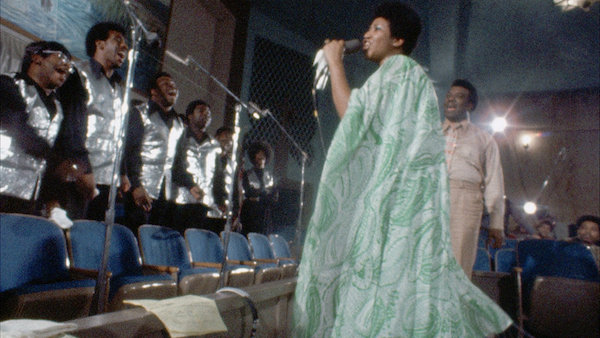Amazing Grace: Soaring Pipes To Soothe The Soul
Amazing Grace is a documentary “realized” by Alan Elliot that showcases one of the most incredible vocal talents the world has ever seen at the height of her power. Originally shot by actor/director Sydney Pollack, the film presents Aretha Franklin with choir at the New Temple Missionary Baptist Church in Los Angeles in January 1972. Due to a complication, the footage has been collecting dust in the Warner Bros. vault, but thanks to Alan Elliot (who spent 2 years putting it together), it’s now here for all of us to enjoy.
The film features Aretha Franklin recording her fourth live album, Amazing Grace. Released on June 1, 1972 by Atlantic Records, it ultimately sold over two million copies in the United States alone, earning a double platinum certification. As of 2017, it stands as the biggest selling disc of Franklin's entire fifty-plus year recording career as well as the highest selling live gospel music album of all time.
Hearing Franklin’s voice booming through the stereo is a powerful — some may even say “spiritual” — experience, but this long overdue visual component to her bestselling gospel record adds a whole new layer. We’ve all heard Franklin’s impressive pipes, but very few of us have witnessed the impact her voice had on her audience, and Amazing Grace gives us that opportunity. We get to see the church crowd as they respond to Franklin’s vocal gift and watch as the sweat pours down her face by the bucket as she belts out another heartfelt hymn. It’s an incredibly moving performance with a few powerful and touching moments, but the execution doesn’t exactly give the “Queen of Soul” her due R-E-S-P-E-C-T. Of course, there’s a story there, and it’s a pretty baffling one.
Warner Bros. commissioned Sydney Pollack to direct the live performance back in ‘72, which they planned to release as part of a double bill with Super Fly — an odd combination of exploitation sinning and angelic gospel salvation. Pollack assembled a crew and captured the performance (he even appears briefly throughout the documentary); however, he made one fatal mistake. It turns out the crew never used a clapboard, which helps to synchronize the audio and video in the editing process. At this juncture in Pollack’s career, he had directed 5 or 6 films, in addition to several episodes of TV, so it’s somewhat hard to believe that he made such a rookie error, but due to his oversight, the footage has been sitting, unseen, collecting dust in the Warner Bros. vault. for the last four decades, which is where Alan Elliot enters the picture.
Shortly before Pollack’s passing in 2008, he turned over the footage to producer Alan Elliot, who then spent the next two years manually syncing Pollack’s imagery with the audio of Franklin’s extraordinary voice. His Herculean effort untangling Pollack’s mess to put this spectacle together is greatly appreciated; however, the story doesn’t quite end there. Elliot tried to premiere the film twice, in 2011 and 2015, but Franklin sued him for using her likeness without permission, despite Elliot having recovered the original contract with Warner Bros. It wasn’t until after she passed away that the film was able to be shown, an it made its first appearance only 3 months after her death on November 12, 2018.
Now that it’s available for mass consumption, it’s something everyone ought to experience. Whether you’re a religiously inclined or not, Amazing Grace has the power to lift you out of the cineplex chair in an energized state of blissful euphoria, rejoicing in a state of “Hallelujah!" — can I get an amen? It’s infectiously overflowing with joyous soul, but outside of delivering unreleased footage to a live album we could already hear, it unfortunately doesn’t do much else. It’s similar to this year’s Apollo 11 in that regard, but isn’t as riveting in a cinematic sense. Pollack covers the two-day event with a unfocused looseness, a point the camera and hope for the best approach, but what can you expect from a guy who forgot to bring a clapboard.
For the most part, editor Jeff Buchanan presents the experience as smoothly as possible, but there’s some noticeably clunky sections, like a few moments of unnecessary split screen in an attempt to keep the energy up (which was already raised by the performance). There also wasn’t enough long, lingering shots on Franklin singing, which would have let the power of her incredible voice sink in with a bit more effect. The film only presents brief glimpses of the behind the scenes preparation, and the little that’s there doesn’t provide any new insight into Franklin as an artist.
Still, it’s got some cool moments, like Aretha’s father’s heartfelt speech, Reverend James Cleveland’s jovial energy, and Mick Jagger popping in to check out the recording. It probably won’t bring you to Jesus, if you weren’t already in that camp, and it probably won’t drastically change your life, but it sure is a soothing, soulful sight to behold.
Recommendation: For fans of Aretha Franklin, this is an absolute must, and it benefits from being seen in a theater. To the uninitiated, it serves as a powerful entry point.
Rating: 3 cries of jubilation outta 5.
What are you thoughts on the film? Did seeing Aretha sing heighten the impact for you? We want to know. Share your thoughts and feelings in the comments section below, and as always, remember to viddy well!



